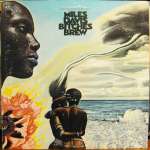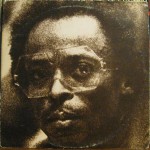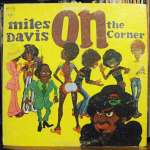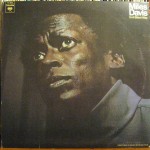March 4, 2015 | Posted in JAZZ, PROGRESSIVE ROCK | By Jason Sositko
Miles brought many diverse genres together
Here in the 21st Century world music is king, all types of sounds are emanating from diverse parts of the globe, they are finding their way into every contemporary music imaginable.
Miles Davis used African rhythms and world percussion elements, as well as Indian instruments in his 1969-1975 music. Davis took a kitchen sink approach to his art during the 1970’s, trying nearly everything out that was new electronically it seemed, until he found what it was he was looking for during a particular time period.
His electric music is being re-discovered by those who didn’t understand it, and discovered for the first time by the younger generation who are searching for the Rosetta Stone of whatever melting pot genre of music they are into today.
The electric music is highly influential on today’s electronic musicians, funk & hip hop musicians, as well as drum & bass, dance, trance, and ambient musicians are displayed on the pictured album Get Up With It.
One of the problems was, conservative jazz critics could not wrap their minds around the music because it was not really jazz, some of it was new music all together.
Rock critics didn’t really know what to make of it either, as it was so far advanced to them, even with the rock and funk style rhythms.
In a Silent Way (1969)
1969’s In a Silent Way is where Miles Davis left Jazz completely, and where the jazz establishment critics broke their legs jumping off the Miles Davis band wagon.
How does In a Silent Way fit into this conversation? Well, simply put, this was the beginning, at least the beginning that mattered for jazz rock and electronic music.
I realize that Gary Burton and Tony Williams were forming their own bands at this time, and experimental bands like Frank Zappa, Can, and The Velvet Underground were forging some unique music in their own right.
Miles Davis and his headlong dive into the jazz rock style, gave more legitimacy to the music, and gave rock/jazz critics another avenue to champion or deride the music.
In a Silent Way sold well, but nothing like the next album Bitches Brew, which sold 500,000 copies, an astounding number for the time. A typical jazz album would sell 30,000 copies, but as the critics said, this ain’t jazz.
Electronic musician and arranger Brian Eno had to have been affected by Davis, he like myself, discovered Miles from the Bitches Brew era and then worked backward into the catalog, I hear a lot of Miles electric in Eno’s music.
When I drop the needle on an original Columbia 2 eye vinyl copy of In a Silent Way, I can’t help but smile when I think about some of the electronic ambient music being made today. No way can you can deny how important this music is on today’s younger artists, in and out of jazz.
For me the dominate sound within In a Silent Way is the Fender Rhodes electric piano, a sound that adds this clean refreshing vibe to the music. The sound cuts through the mix well, and actually adds something that an acoustic piano can not deliver, I know, say that is heresy right? I don’t mean to denigrate the acoustic piano, I can understand why those in jazz went crazy when this new “Toy” piano was introduced into jazz.
Once the Fender Rhodes started dominating the overall aesthetic of the music, the jazz critics went insane. I bet they nearly dropped dead when the Moog Synthesizer revealed its self within jazz rock and funk music down the line.
Why did I choose In a Silent way over Bitches Brew for my first of three listed here? Bitches Brew is just too avant-garde and experimental in nature on a whole, and In a Silent way is sort of the Yin to Bitches Brew’s Yang.
Miles still sounds bluesy and jazzy with his solo statements however, I suppose that’s why this music is called jazz rock. I don’t feel comfortable calling it either one, I just call it great music.
On the Corner (1972)
On the Corner was the album where the jazz established not only broke their legs jumping off the band wagon, they drove it of a cliff. I try to envision what this album must have sounded like in 1972? Bitches Brew was pretty out there, if you didn’t like that, no way were you going to warm up to On the Corner.
The critics hated this album, and rock critics weren’t real sure what to make of it either.
The old expression “Time heals all wounds” perfectly describes On the Corner, an album that 40 years later makes perfect sense compared to it’s a prophet always goes unloved in his own country” relevance in 1972.
Today On the Corner truly is a Rosetta Stone of sorts, think about drum n’ bass, as well as dub, trance, and world beat? All of these genres were either influenced by On the Corner.
Droning, churning, and swirling rhythms that seem to go no where, permeate the music. This was the big complaint at the time with critics, and that complaint, is actually its strength in my mind. The reason it has been so influential to the generations of beat-doctors to come.
On the Corner also has a street wise vibe, very organic in nature, much like the album cover. Miles was surely going for this vibe, he was really trying to appeal to the African-American culture at the time, as the Corky McCoy album cover would plainly state.
It just so happened that critics especially, and even the public, weren’t ready for this new music that was at least 10 years ahead of its time. Heck, probably 40 years ahead its time!
Reportedly Miles was actually being influenced somewhat by electronic composer Karlheinz Stockhausen, though I hardly think Miles was cruising in his Ferrari listening to 8 track tapes of the Kontra-Punkte or anything, but Miles was aware of him.
The single biggest lasting influence for today’s musician, maybe even more so than the music its self, is the way the music was put together. Drum and bass grooves laid the foundation, then snippets of long studio jams were spliced in to create the music; a real foreshadowing of the standard practice in the studio today.
This computerized editing technique, all be it crude by today’s standards, adds something to the music’s modern vibe I think.
Get Up With It (1974)
I have listened to the Music of Miles Davis for 20 years now. I still remember the first time I heard Kind of Blue, it was a life changing experience for me. Previously I had no idea what serious music was, the kind of music that demands attention.
Music is a powerful force, and I doubt you will ever hear a more varied and powerful instrumental album in your life than Get Up With it.
I am talking about a beautiful soulful walk on the beach rhythm, then the nastiest voodoo funk beat you will ever hear, and some of the meanest bizarre tuned guitar (Pete Cosey), and trumpet sounds (Miles) you will ever taste in your life.
Then you have one of the most underrated jazz instrumentalists of all time David Liebman on soprano sax and flute, That dude can play.
Bassist Michael Henderson and drummer Al Foster lay down some of chunkiest bass and drum beats on “Calypso Frelimo,” “Honky Tonk,” & “Red China Blues”. These offer a real commercial blues vibe to the music that breaks up the hard funk of “Calypso Frelimo”.
The opening track “He Loved Him Madly”is a tribute to the recently deceased before the recording Duke Ellington (1899-1974). The track sure doesn’t sound like anything the Duke ever laid to tape before. In fact, I can’t think of anything that resemblesthe 1974 recording.
Some seriously ambient tones are going on. The music sounds like something you would hear from new age artists 10 years later. The point is, many an artist made a cottage industry out of this style.
I have grown to appreciate Get Up With It. There really is something for everyone, this double album with over 2 hours of music keeps you on the edge of your seat.
Get Up With It has to surely be the most underrated album in the entire discography of Miles Davis. What a way to go out, as this was Miles Last studio album for nearly 8 years.
Things never became this groundbreaking again for Miles, as he tended to play it safe a bit after his come back. I think Miles probably just eased into the elder statesmen role, he never returned to his past for than a fleeting moment.
The 80’s music does have just enough of the Get Up With It vibe to remind you how great the electric years music was between 1968 and 1975.
I chose the above 3 records as a place to start if you don’t have a jazz back ground. Because of the variety in styles, I have a hard time believing a person with a an open mind couldn’t find something in the music to like.
Albums like Bitches Brew and Big Fun, are waiting to be discovered too. Miles has plenty of live documents available from the 69-75 time period for you to discover as well. Dark Magus, Agharta, and Pangaea are only a few of the sessions ready to be unearthed.
Related posts at Spacial Anomaly
Table of Contents
Jason Sositko
Jason Sositko, a freelance writer and entrepreneur is a participant in the Amazon Services LLC Associates Program, an affiliate advertising program designed to provide a means for sites to earn advertising fees by advertising and linking to Amazon.com. I also use services such as Viglink and Skimlinks to earn income via links placed inside articles.
Leave a Reply
*















Be the first to comment.